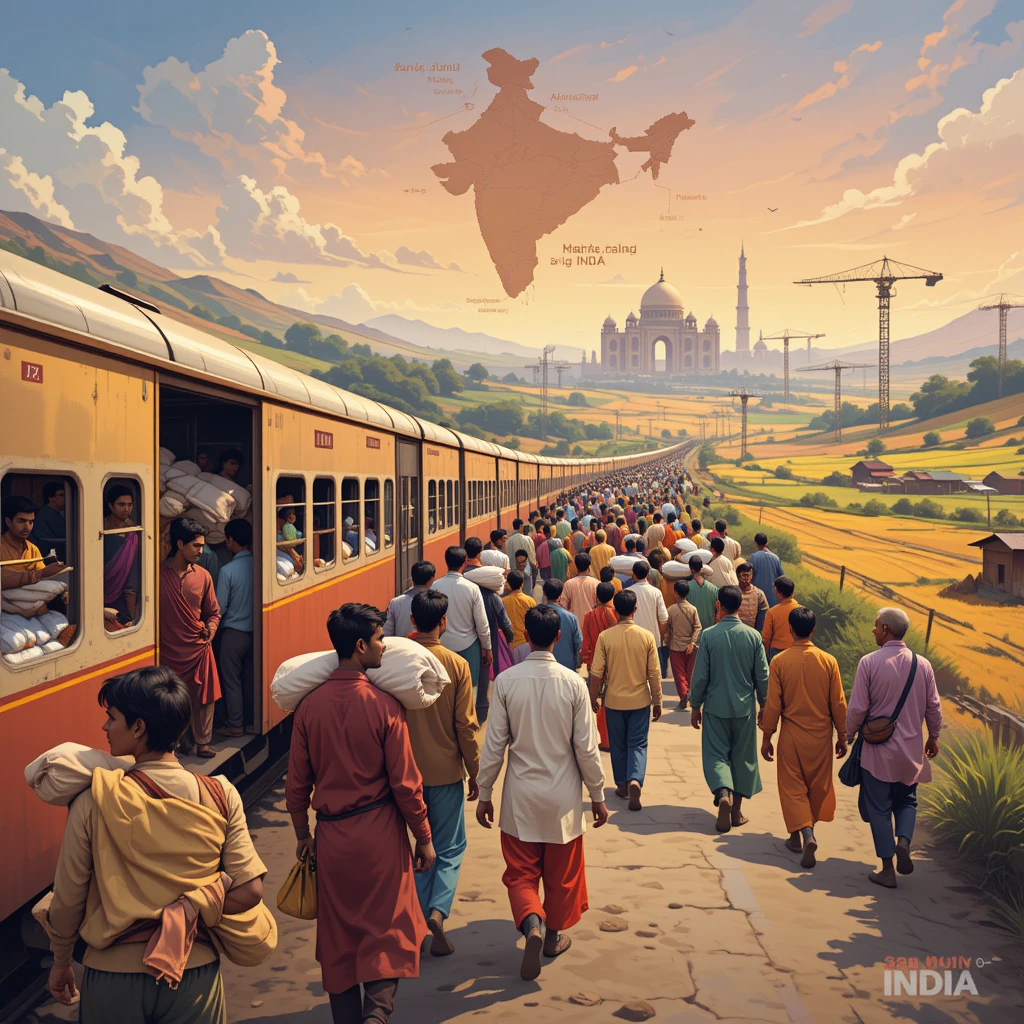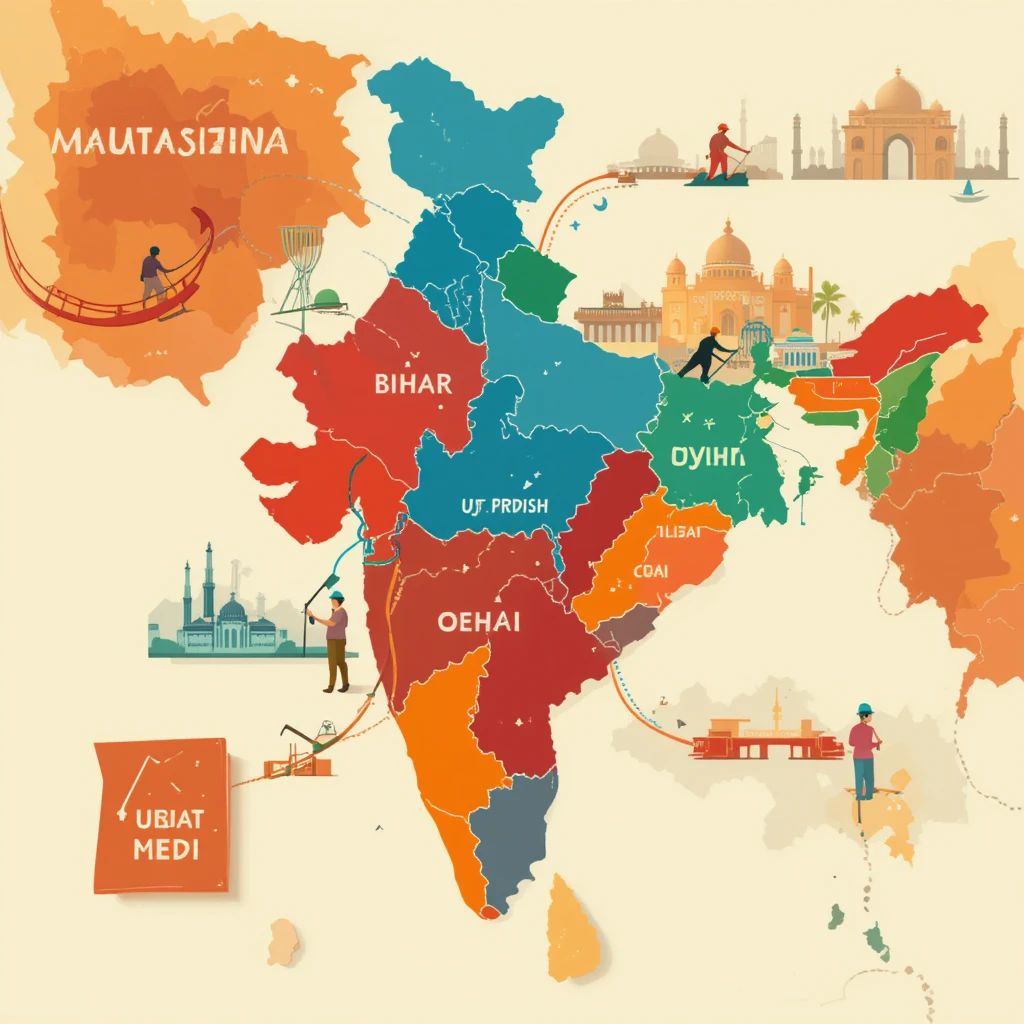Interstate labor migration is a defining feature of India’s socioeconomic landscape, reflecting deep-seated regional disparities in economic opportunities, wages, and living conditions. As of August 2025, India’s economy has largely recovered from the disruptions of the COVID-19 pandemic, leading to a resurgence of migration flows, particularly among rural workers seeking employment in urban and industrial centers. States such as Bihar, Uttar Pradesh (UP), and Odisha are primary sources of out-migration, while Maharashtra, Delhi, and Gujarat attract significant inflows. This article provides an in-depth exploration of the states involved, the multifaceted reasons for migration, the critical role of unemployment in origin states, the paradox of land-owning farmers turning to migratory labor, and the wage disparities driving these movements. Drawing on data from the 2011 Census, Periodic Labour Force Survey (PLFS), India Employment Report 2024, and other authoritative sources, it examines the implications of migration for India’s economy and society, concluding with policy recommendations to address distress migration and promote equitable development. This comprehensive analysis, spanning over 4,000 words, aims to offer a nuanced understanding of one of India’s most pressing socioeconomic challenges.

Table of Contents
Migration Patterns: Origin and Destination States
India’s internal migration is a complex phenomenon, with interstate labor migration forming a significant component. According to the 2011 Census, approximately 54 million Indians were interstate migrants, with labor migration accounting for a substantial share, particularly among young males aged 15-34. The Periodic Labour Force Survey (PLFS) 2023-24 and other recent studies estimate that over 15 million workers migrate annually across state borders, driven by economic necessity. The post-COVID recovery has intensified these flows, as urban economies rebound and rural distress persists. Migration is predominantly rural-to-urban or rural-to-rural, with workers moving from economically backward agrarian states to industrialized or urbanized hubs.

Out-Migration States
States with high out-migration are typically characterized by poverty, agricultural distress, and limited industrial or service-sector growth. These “origin” states face structural challenges that push workers to seek livelihoods elsewhere.
- Uttar Pradesh (UP): As India’s most populous state, with over 200 million residents, UP is the largest source of interstate migrants. The 2011 Census reported that UP, alongside Bihar, contributes nearly 50% of India’s interstate migrant labor force. Eastern UP districts, such as Gorakhpur, Azamgarh, and Jaunpur, are hotspots for out-migration due to overpopulation, fragmented landholdings, and stagnant rural economies. Workers from UP are found in construction sites in Delhi, factories in Gujarat, and agricultural fields in Punjab. The state’s high population density (829 persons per sq. km) exacerbates pressure on resources, driving migration.
- Bihar: Chronic underdevelopment, coupled with a lack of industrial growth, makes Bihar a major out-migration hub. Approximately 10 million workers leave annually, with destinations including Maharashtra, Delhi, and Punjab. The state’s rural economy, heavily reliant on subsistence agriculture, cannot absorb its growing workforce. Districts like Muzaffarpur and Darbhanga see significant outflows, with migrants working in low-skill sectors like construction, brick kilns, and informal services. Bihar’s contribution to national migration flows is substantial, with PLFS data indicating that it accounts for a significant portion of male migrant workers.
- Odisha: Known for its tribal and coastal belts, Odisha sends over 5 lakh workers annually to states like Andhra Pradesh, Tamil Nadu, and Gujarat. Migration from Odisha is often distress-driven, with tribal districts like Kalahandi and Koraput facing acute poverty and climate-induced agricultural challenges. Workers migrate for seasonal employment in brick kilns, construction, and plantation agriculture, returning home during sowing or harvest seasons.
- Other Key Origin States: Jharkhand, Madhya Pradesh (MP), Rajasthan, and West Bengal also contribute significantly to out-migration. Jharkhand’s tribal population migrates to work in tea plantations in Assam or construction in Karnataka. Madhya Pradesh sees outflows from its Bundelkhand region due to drought and unemployment. Rajasthan’s arid zones push workers to Gujarat’s industrial belts, while West Bengal’s rural workers head to Delhi and Maharashtra. Collectively, these states account for over 70% of interstate labor outflows, as per the 2017 Working Group on Migration report.
In-Migration States
Destination states attract migrants with robust industrial, construction, and service sectors, offering higher wages and job opportunities. These states benefit from migrant labor, which fills critical gaps in low-skilled sectors and supports economic growth.
- Maharashtra: Home to India’s financial capital, Mumbai, and industrial hub, Pune, Maharashtra is the top destination for interstate migrants. The state’s construction boom, textile industries, and informal sector jobs draw workers from UP, Bihar, and Odisha. Mumbai alone hosts millions of migrants in slums like Dharavi, working in small-scale manufacturing and services.
- Delhi: The National Capital Region (NCR) accounts for over 50% of in-migration inflows, according to PLFS 2023-24. Delhi’s service sector, infrastructure projects, and informal economy attract workers from UP, Bihar, and West Bengal. Construction of metro lines, commercial buildings, and residential complexes relies heavily on migrant labor.
- Gujarat: Industrial hubs like Ahmedabad, Surat, and Vadodara make Gujarat a magnet for migrants. The state’s textile, chemical, and diamond polishing industries employ workers from Rajasthan, UP, and Odisha. Surat’s diamond polishing units alone absorb thousands of migrants annually.
- Other Destination States: Karnataka (Bengaluru’s IT and manufacturing sectors), Tamil Nadu (Chennai and Coimbatore’s factories), Kerala (construction and plantation work), and Punjab/Haryana (agriculture and agro-industries) are significant hubs. Kerala’s construction sector, fueled by remittances and urban growth, employs workers from Odisha and Assam. Punjab and Haryana rely on migrant labor for wheat and rice harvesting, drawing workers from Bihar and UP.
The post-COVID period has seen a surge in migration to these states, driven by urban infrastructure projects under initiatives like the Smart Cities Mission and industrial growth in Gujarat and Tamil Nadu. The temporary reverse migration during the 2020 lockdowns has largely reversed, with urban pull factors dominating by 2024.
Reasons for Interstate Migration
Interstate migration in India is primarily economic, driven by a complex interplay of push and pull factors. These factors reflect structural inequalities, agricultural challenges, and urban opportunities, shaping migration as both a survival strategy and a pursuit of better livelihoods.
Push Factors in Origin States
- Economic Disparities and Poverty: States like Bihar, UP, and Odisha face chronic poverty, with per capita incomes significantly below the national average (e.g., Bihar’s per capita income is Rs 57,000 compared to India’s Rs 1.7 lakh in 2023-24). Low agricultural yields and limited non-farm employment force workers to seek alternatives elsewhere. Migrants’ remittances, estimated at $14 billion annually, are critical for household survival in these states, highlighting their economic dependency on migration.
- Agricultural Distress: Rising input costs (seeds, fertilizers, pesticides) and volatile crop prices trap farmers in debt. The National Sample Survey (NSS) 70th Round shows that 50% of agricultural households are indebted, with average debt levels of Rs 47,000. Crop failures due to erratic monsoons or pest attacks further erode incomes, pushing workers to migrate for supplementary earnings.
- Climate Change and Environmental Stress: Climate-induced challenges, such as droughts in Odisha’s Kalahandi or floods in Bihar’s Kosi region, disrupt farming. The India Meteorological Department reports that 40% of India’s districts face erratic rainfall, reducing agricultural productivity. This forces small farmers and landless laborers to seek work in states with more stable economies.
- Unemployment and Underemployment: Rural unemployment, particularly seasonal, is a major driver. The India Employment Report 2024 notes that rural youth unemployment in Bihar and UP ranges from 15-20%, with underemployment affecting over 40% of the workforce. Limited industrial growth and competitive labor markets exacerbate joblessness, pushing workers to urban centers.
- Social Vulnerabilities: Marginalized communities, including Scheduled Castes (SCs), Scheduled Tribes (STs), and Other Backward Classes (OBCs), face land alienation and social discrimination, limiting local opportunities. In Jharkhand and Odisha, tribal farmers often lease out land at low rates, turning to migration for survival.
Pull Factors in Destination States
- Higher Wages and Job Opportunities: Destination states offer significantly higher wages, as discussed later. Construction jobs in Delhi or Maharashtra pay Rs 450-600/day, compared to Rs 250-300/day in Bihar. Seasonal agricultural work in Punjab or plantation jobs in Kerala also attract migrants with better pay.
- Urbanization and Industrial Growth: Rapid urbanization, driven by initiatives like the Smart Cities Mission, creates demand for construction workers. Industrial hubs in Gujarat and Tamil Nadu offer factory jobs, while Bengaluru’s IT-driven economy supports ancillary services employing migrants.
- Network Effects: Migrant networks facilitate job access, with communities from specific villages forming labor supply chains to destinations. For instance, workers from Bihar’s Madhubani district dominate certain construction sites in Delhi, relying on kinship ties for recruitment.
The COVID-19 pandemic disrupted these patterns, with millions returning to origin states during the 2020 lockdowns. However, by 2024, migration rebounded as urban economies recovered, underscoring the resilience of these push and pull dynamics.
The Role of Unemployment in Origin States
Unemployment, particularly in rural areas, is a central driver of out-migration in states like Bihar, UP, and Odisha. The lack of local job opportunities, coupled with structural economic challenges, forces workers to seek livelihoods elsewhere, often under precarious conditions.
Unemployment Trends
- High Unemployment Rates: The India Employment Report 2024, published by the International Labour Organization (ILO) and Institute for Human Development, highlights that youth unemployment (aged 15-29) in Bihar, UP, and Odisha ranges from 15-20%, compared to the national average of 6.5%. Rural unemployment in these states is around 7-8%, but underemployment—where workers are employed below their skill or time capacity—affects over 40% of the workforce. For instance, Bihar’s rural workforce faces seasonal joblessness during non-agricultural months, pushing workers to migrate.
- Structural Challenges: Limited industrial growth in origin states exacerbates unemployment. Bihar’s share of manufacturing in state GDP is only 2%, compared to 16% in Gujarat. UP and Odisha also lag in industrial and service-sector development, leaving agriculture as the primary employer. However, agriculture absorbs only 45% of the rural workforce effectively, with surplus labor driving migration.
- MGNREGA Limitations: The Mahatma Gandhi National Rural Employment Guarantee Act (MGNREGA) provides 100 days of guaranteed work at Rs 200-300/day, but this is insufficient to meet household needs. In 2023-24, only 50% of registered households in Bihar received the full 100 days, and wages remain below market rates in destination states. This gap pushes workers to migrate for better earnings.
Impact on Migration
Unemployment directly fuels distress migration, where workers move not by choice but necessity. In Bihar, competitive labor markets and a surplus of unskilled workers depress local wages, making migration to Delhi or Maharashtra more viable. PLFS data indicates that over 12 million workers migrated interstate in 2023-24 due to unemployment pressures, with Bihar and UP contributing the lion’s share. Migration is often seasonal or circular, with workers returning for sowing or harvesting but spending 6-8 months annually in destination states.
Socioeconomic Consequences
The exodus of young, working-age men depletes local talent pools, perpetuating underdevelopment in origin states. Remittances—estimated at Rs 1.5 lakh crore annually from UP and Bihar—provide a lifeline, funding education, healthcare, and debt repayment. However, they do not address structural issues like poor infrastructure, inadequate education, or lack of industrial investment. High unemployment also strains social cohesion, with families relying on single migrant earners, increasing vulnerability to economic shocks, as seen during the COVID-19 crisis.
Why Land-Owning Farmers Migrate as Laborers
One of the most striking paradoxes of Indian migration is the phenomenon of land-owning farmers working as farm or construction laborers in other states. This reflects the deepening crisis in Indian agriculture, where small and marginal farmers—86% of the total, owning less than 2 hectares—face insurmountable challenges.
Challenges of Small-Scale Farming
- Fragmented and Uneconomic Holdings: The average landholding size for marginal farmers is 0.38 hectares, reduced by inheritance laws that fragment land across generations. The Agricultural Census 2015-16 shows that 86% of farmers own less than 2 hectares, yielding insufficient income to sustain families. In states like Bihar, where population density is high, land fragmentation is acute, with plots too small for mechanization or economies of scale.
- Debt and Low Returns: Rising input costs (seeds, fertilizers, pesticides) and volatile crop prices trap farmers in debt. The NSS 70th Round reports that 50% of agricultural households are indebted, with average debt of Rs 47,000. Crop failures due to pests, unseasonal rains, or market crashes exacerbate financial distress. Many farmers borrow from informal lenders at 20-30% interest rates, forcing them to seek wage work to repay loans.
- Climate and Resource Constraints: Only 48% of India’s farmland is irrigated, with states like Bihar (52% irrigated) and Odisha (30%) heavily reliant on monsoons. Climate change, including erratic rainfall and droughts, reduces yields. For instance, Odisha’s Kalahandi district faces recurrent droughts, pushing farmers to migrate to Andhra Pradesh’s plantations or Tamil Nadu’s factories.
- Lack of Support Systems: Limited access to affordable credit, crop insurance, and extension services leaves farmers vulnerable. The Pradhan Mantri Fasal Bima Yojana covers only 30% of farmers, with bureaucratic delays hindering payouts. Declining groundwater levels and poor soil fertility further erode productivity.
Social and Economic Pressures
Marginalized communities, such as Scheduled Tribes in Odisha or Scheduled Castes in UP, face additional challenges. Land alienation, where tribal farmers lose land to non-tribal buyers or lease it at low rates, is common in Jharkhand and Odisha. These farmers often become landless or semi-landless, migrating as laborers. Even those retaining land may lease it out and work as construction laborers in cities or farmworkers in Punjab, where wages (Rs 400-500/day) exceed local agricultural earnings (Rs 250-300/day).
Circular Migration
Many small farmers engage in circular migration, farming during sowing or harvest seasons and migrating for 6-8 months to work as laborers. In Punjab and Haryana, they join agricultural labor gangs for wheat or rice harvesting, while in Delhi and Mumbai, they work in construction. This dual role reflects the unviability of small-scale farming, where income from land (e.g., Rs 10,000-20,000/year for marginal farmers) is far below the poverty line.
Wage Disparities Across States
Wage differentials are a primary pull factor for interstate migration, with destination states offering significantly higher pay than origin states. Data from the Labour Bureau’s Wage Rate Index and RBI’s Handbook of Statistics (2023-24) highlight these disparities, which drive workers to endure exploitation for better earnings.
High-Wage States
- Kerala: Leads with agricultural wages at Rs 807/day and construction wages at Rs 893/day, nearly triple the national averages (agriculture: Rs 372; general: Rs 417). Strong labor unions, high literacy, and a remittance-driven economy sustain these rates. Migrants from Odisha and Assam dominate Kerala’s construction and plantation sectors.
- Tamil Nadu: Offers Rs 540/day for agricultural labor and similar rates for construction. Industrial growth in Chennai, Coimbatore, and Tiruppur attracts workers from Bihar and Odisha for textile and manufacturing jobs.
- Punjab and Haryana: Agricultural wages range from Rs 400-500/day, with construction slightly higher. Mechanized farming still requires migrant labor for planting and harvesting, drawing workers from UP and Bihar.
- Maharashtra and Gujarat: Urban construction wages range from Rs 450-600/day, driven by infrastructure and real estate booms. Surat’s textile and diamond industries and Mumbai’s construction sites are major employers.
Low-Wage States
- Bihar and UP: Agricultural wages are Rs 250-300/day, with construction at Rs 300-400/day. Surplus labor and low productivity depress wages, making migration to high-wage states attractive.
- Odisha and Madhya Pradesh: Similar wage ranges, with construction wages as low as Rs 200-300/day in some areas. Tripura and MP rank among the lowest for non-agricultural wages.
These gaps—e.g., Kerala paying three times Bihar’s rates—explain why migrants tolerate poor working conditions. However, weak enforcement of minimum wages in informal sectors (90% of migrant jobs) leads to exploitation, with workers often paid below statutory rates.
Socioeconomic Implications of Migration
Interstate migration has profound implications for both origin and destination states, shaping India’s economic and social landscape.
Benefits
- Economic Growth: Migrants fill labor shortages in destination states, supporting industries like construction (20% of India’s GDP) and agriculture. Remittances boost household incomes in origin states, funding education, healthcare, and debt repayment.
- Urban Development: Migrants contribute to urbanization, working on infrastructure projects like metro systems and highways. Their labor supports India’s goal of becoming a $5 trillion economy by 2027.
Challenges
- Exploitation and Vulnerability: Migrants face wage theft, unsafe working conditions, and lack of social security. The Inter-State Migrant Workmen Act, 1979, is poorly enforced, leaving workers unprotected.
- Strain on Origin States: Out-migration depletes human capital, hindering local development. Women and children left behind face increased burdens, with social issues like child labor rising in some areas.
- Urban Overcrowding: Destination cities like Mumbai and Delhi face slum proliferation and infrastructure strain due to migrant inflows. Over 40% of Mumbai’s population lives in slums, many of them migrants.
The COVID-19 crisis exposed these vulnerabilities, with millions of migrants stranded during the 2020 lockdowns, highlighting the need for better migration governance.
Policy Recommendations
Addressing distress migration requires a multi-pronged approach targeting root causes and improving migrant welfare:
- Rural Job Creation: Expand MGNREGA to 200 days of guaranteed work and increase wages to Rs 400/day to reduce migration pressure. Invest in rural industries, such as food processing in Bihar, to create local jobs.
- Agricultural Reforms: Consolidate small landholdings through cooperative farming models, as piloted in Gujarat. Expand irrigation coverage to 70% of farmland and enhance crop insurance penetration to 50% of farmers. Subsidize inputs to reduce debt.
- Migration Governance: Implement NITI Aayog’s 2021 draft migration policy, ensuring portable social security, affordable housing, and wage protection. Establish migrant resource centers in destination states to provide legal aid and healthcare.
- Skill Development: Train rural youth in skills like masonry or welding to improve employability in non-agricultural sectors, reducing dependency on low-wage jobs.
- Regional Development: Invest in industrial corridors in high out-migration states, such as UP’s Purvanchal Expressway, to create local opportunities. Improve education and healthcare to retain talent.
- Wage Enforcement: Strengthen enforcement of minimum wages in informal sectors through labor inspections and digital wage payment systems to reduce exploitation.
Conclusion
Interstate labor migration in India is a complex phenomenon driven by economic disparities, unemployment, agricultural distress, and wage differentials. While it fuels economic growth in destination states and supports households in origin states through remittances, it also exposes workers to exploitation and perpetuates regional inequalities. The paradox of land-owning farmers migrating as laborers underscores the crisis in Indian agriculture, where small holdings are no longer viable. By addressing root causes—unemployment, agricultural unviability, and wage gaps—through targeted policies, India can transform migration from a distress-driven necessity into an opportunity for inclusive growth. As the country aims for a $5 trillion economy, balancing regional development and protecting migrant workers will be critical to ensuring equitable progress.
References
- Census of India 2011. (2011). Migration Tables. Office of the Registrar General & Census Commissioner, India.
- Periodic Labour Force Survey (PLFS) 2023-24. (2024). Annual Report. National Statistical Office, Ministry of Statistics and Programme Implementation, Government of India.
- India Employment Report 2024. (2024). Youth Employment, Education, and Skills. International Labour Organization and Institute for Human Development.
- Working Group on Migration. (2017). Report of the Working Group on Migration. Ministry of Housing and Urban Poverty Alleviation, Government of India.
- National Sample Survey (NSS) 70th Round. (2014). Situation Assessment Survey of Agricultural Households. National Statistical Office, Government of India.
- Agricultural Census 2015-16. (2016). All India Report on Number and Area of Operational Holdings. Ministry of Agriculture and Farmers Welfare, Government of India.
- Reserve Bank of India. (2023). Handbook of Statistics on Indian Economy 2023-24. RBI.
- Labour Bureau. (2024). Wage Rate Index. Ministry of Labour and Employment, Government of India.
- NITI Aayog. (2021). Draft National Migrant Labour Policy. Government of India.
- India Meteorological Department. (2024). Annual Climate Summary. Ministry of Earth Sciences, Government of India.
- Bhagat, R. B., & Keshri, K. (2020). Internal Migration in India: Trends and Challenges. Economic and Political Weekly, 55(44).
- Deshingkar, P., & Akter, S. (2021). Migration and Development in India: The Case of Circular Migration. Routledge India.
- Tumbe, C. (2018). India Moving: A History of Migration. Penguin Random House India.



